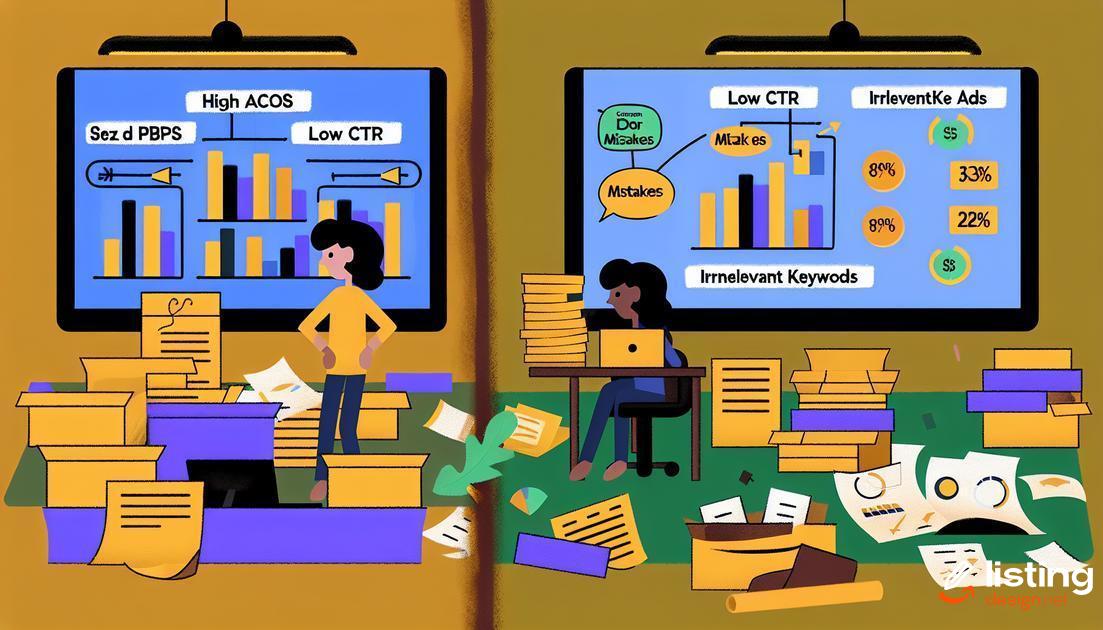Amazon PPC ROI is crucial for e-commerce sellers looking to maximize their advertising spend. Getting a good return on investment ensures your campaign is profitable and sustainable. In this article, we’ll explore essential strategies, key metrics, and tools to help you achieve optimal results. By understanding and implementing these best practices, you can avoid common pitfalls and make the most out of your Amazon PPC efforts.
Table of Contents
Understanding Amazon PPC ROI
Amazon PPC ROI (Return on Investment) is a crucial metric that helps you understand the profitability of your campaigns. Monitoring this metric allows you to determine whether your advertising efforts are yielding financial returns that justify your ad spend.
Factors Influencing Amazon PPC ROI
Several factors can influence your PPC ROI on Amazon. These include ad relevance, keyword selection, and bid strategies. Ensuring that your ads are highly relevant to the search terms can lead to higher click-through rates (CTR) and conversion rates (CR), positively impacting your ROI.
Keyword selection is also paramount. The right keywords will attract potential buyers, increasing the chances of converting clicks into sales. Regularly updating and optimizing your keyword list can help maintain a positive ROI.
Bid strategies play a critical role in managing costs and maximizing returns. Setting competitive yet cost-effective bids can help you stay within your budget while achieving desirable results.
Measuring Amazon PPC ROI
To measure your Amazon PPC ROI accurately, you need to track your ad spend, number of clicks, sales generated, and overall revenue. The formula used is:
ROI = (Sales Revenue - Ad Spend) / Ad Spend
This calculation provides a clear picture of your campaign’s profitability, allowing you to make data-driven decisions for future optimizations.
Key Metrics to Track for Amazon PPC

One of the essential factors in optimizing your Amazon PPC campaigns is tracking key metrics. Metrics provide crucial insights into the performance and effectiveness of your advertising efforts. Monitoring these metrics helps pinpoint strengths and weaknesses in your strategy and ensures you are getting the best return on investment (ROI). Impressions measure how often your ads are displayed and can help identify the reach and visibility of your campaigns. Click-through rate (CTR) is the ratio of clicks to impressions and indicates how compelling your ads are to potential buyers. A higher CTR typically means your ads resonate well with your target audience. Conversion rate is the percentage of clicks that result in sales, reflecting the effectiveness of your landing pages and product listings. Cost per click (CPC) shows the average amount you pay for each click, and keeping this cost efficient is critical for maintaining a profitable campaign. Monitoring your Advertising Cost of Sales (ACoS), which is the ratio of ad spend to sales revenue, helps in understanding the profitability of your ads. The lower the ACoS, the better the ROI.
Sales velocity
captures the rate at which your products are selling and can indicate the health of your campaign over time. Return on ad spend (ROAS) is another crucial metric, as it highlights the revenue generated for every dollar spent on ads. A higher ROAS indicates more effective ad spending. Consistently tracking these metrics enables you to make data-driven decisions and optimize your campaigns for better performance and higher ROI.
Strategies to Maximize Amazon PPC ROI
Amazon PPC campaigns can be incredibly effective when managed correctly. To maximize your ROI, use these key strategies:
1. Keyword Research: Leveraging the right keywords is crucial. Use Amazon’s search term report to identify high performing keywords.
2. Negative Keywords: Avoid wasted spend by adding negative keywords that don’t convert. This helps to improve your ad relevance and cost-efficiency.
3. Bid Adjustments: Regularly adjust bids based on performance data. Increase bids for high-performing keywords and lower for those that underperform.
4. Product Listings: Ensure your product listings are optimized with clear, high-quality images, detailed descriptions, and competitive pricing.
5. A/B Testing: Conduct A/B tests on your ads to determine which elements drive better performance. Iterate based on what works best.
6. Monitor Competitors: Keep an eye on your competition to stay competitive. Adjust your strategy based on their strengths and weaknesses.
By implementing these strategies, you can significantly increase your Amazon PPC ROI. Keep optimizing and refining your approach for the best results.
Common Mistakes in Amazon PPC Campaigns

One of the main mistakes in Amazon PPC campaigns is not utilizing negative keywords. Negative keywords help to filter out irrelevant traffic and ensure that your ads don’t appear for searches that are not related to your products. This can significantly save your budget by preventing unnecessary clicks.
Another common error is failing to set a realistic budget. Companies often either overspend or underspend, leading to inefficient use of their advertising funds. A proper budget plan that aligns with your sales goals is crucial in achieving a positive ROI.
Many advertisers also neglect the importance of continuous monitoring and optimization. Simply setting up a campaign and leaving it to run on autopilot can result in missed opportunities for improvement and wasted spend. Regularly reviewing and adjusting bids, keywords, and targeting strategies is essential to maintaining campaign performance.
Another easily overlooked aspect is the relevance of your product listings. Ensuring that your product titles, descriptions, and images are high-quality and SEO-friendly can improve your ad performance. Amazon considers the relevance of your listings when deciding on ad placements.
Ignoring A/B Testing
Failing to test different versions of your ad copy, landing pages, and product images can hinder your ability to find the most effective elements. A/B testing allows you to compare different strategies and identify what works best for your audience.
Lastly, not leveraging Amazon’s available ad formats and placements can limit the reach and effectiveness of your campaigns. Explore Sponsored Products, Sponsored Brands, and Sponsored Display to see which format works best for your products.
Tools for Optimizing Amazon PPC ROI
When it comes to optimizing Amazon PPC ROI, the right tools can make a significant difference. One of the essential tools is Amazon Advertising Console, which provides detailed metrics to track your ad performance. Another indispensable tool is Sellics, an all-in-one platform offering features like automated PPC management, keyword research, and performance analytics. Helium 10 is also effective, particularly for its keyword tracker and ASIN search volume data.
Jungle Scout can be invaluable in finding profitable products and analyzing competitors’ strategies. Meanwhile, Teikametrics leverages AI to optimize bids and budgets for maximum ROI. Don’t overlook PPC Entourage, a tool that helps in automating and scaling your PPC campaigns effortlessly.
Benefits of Using Optimization Tools
These tools save time by automating tedious tasks and provide insights that might be difficult to obtain manually. They also help in precise targeting and bid adjustments, ensuring your ads are shown to the right audience at the right time. Additionally, they enable continuous monitoring and optimization, leading to better performance over time.
How to Analyze Your Amazon PPC Data

Examining your Amazon PPC data is critical for boosting your campaign’s performance. Start by collecting data from Amazon’s Advertising Reports, which offer essential insights into your ad campaigns’ performance metrics.
Key Data Points
Look at metrics like impressions, clicks, click-through rate (CTR), cost per click (CPC), and conversions. These are foundational for understanding how well your ads engage with potential customers.
Advanced Metrics
Analyze advanced metrics such as Advertising Cost of Sales (ACoS) and Total Advertising Cost of Sales (TACoS). ACoS helps you understand the profitability of your ads by comparing ad spend to sales, while TACoS considers the impact of your ad spend on total sales, including organic sales.
Segmentation
Segment your data to identify patterns and trends. Break down metrics by campaign, ad group, and keyword to see which elements are performing well and which need adjustment. Identify high-performing keywords to increase bids and low-performing keywords to either optimize or pause.
Using these insights, you can refine your Amazon PPC strategy for better ROI.
Case Studies: Successful Amazon PPC Campaigns
Examining successful Amazon PPC campaigns can provide valuable insights into what works and what doesn’t. These case studies show how businesses across various niches have leveraged PPC advertising to achieve significant returns. By understanding their strategies, adaptations, and the metrics they focused on, you can gain actionable takeaways to enhance your own campaigns.
1. Niche Product Success
A small business selling niche products experienced a surge in sales after refining their keyword targeting. They focused on long-tail keywords, which not only reduced costs but also enhanced relevance. This shift led to a higher click-through rate (CTR) and conversion rate, boosting their overall ROI.
2. Seasonal Adjustments
An eCommerce store specializing in seasonal items adapted their PPC strategies according to shopping trends. By analyzing historical data and forecasting demand, they adjusted budgets and bids leading up to high-traffic periods. This proactive approach helped them capitalize on peak seasons, resulting in a substantial increase in sales.
3. Brand Awareness Campaign
A well-known brand aimed to increase its market share through a comprehensive PPC campaign. By investing in sponsored brand ads, they enhanced visibility and drove more traffic to their product pages. They also used A/B testing for their ad creatives, identifying the most effective designs and copy. This iterative process improved their ROI significantly.
4. Competitor Targeting
An innovative company utilized competitor targeting to attract customers. They bid on competitor brand names and products, positioning their ads to appear when users searched for similar items. This strategy not only diverted traffic from competitors but also introduced their products to a broader audience, resulting in increased conversions and ROI.
5. Product Line Expansion
A retailer expanded their product line and used a strategic PPC campaign to promote new items. They segmented their ads by product categories and tailored their keywords and bids. By closely monitoring performance and making data-driven adjustments, they successfully launched new products and maximized their return on investment.
Future Trends in Amazon PPC Advertising

As technology evolves, Amazon PPC advertising is set to undergo significant changes. Emerging trends promise to make campaigns more efficient and profitable. One notable trend is the use of artificial intelligence (AI). AI can automate bidding strategies, targeting, and even ad creation. This automation can save time and enhance the accuracy of ad placements, leading to a better return on investment (ROI).
Another trend is the increasing importance of voice search. With more consumers using devices like Amazon Alexa, optimizing PPC campaigns for voice search keywords can become a critical factor in campaign success. It requires understanding natural language queries and incorporating long-tail keywords that align with voice-based search patterns.
Moreover, the rise of video ads is set to impact Amazon PPC strategies. Video content is highly engaging and can capture the attention of potential buyers more effectively than traditional text-based ads. Incorporating video into PPC campaigns can drive higher click-through rates and conversions, thereby improving overall campaign performance.
The integration of advanced analytics is another trend shaping the future of Amazon PPC. With sophisticated analytics tools, advertisers can gain deeper insights into campaign performance, customer behavior, and market trends. These insights enable more data-driven decisions, optimizing campaigns for better results.
Lastly, there’s an increasing emphasis on personalization. Tailoring ads to individual preferences and past behaviors can make ads more relevant and compelling. Leveraging customer data to create personalized ad experiences can drive higher engagement and conversions, leading to a more significant PPC ROI.


